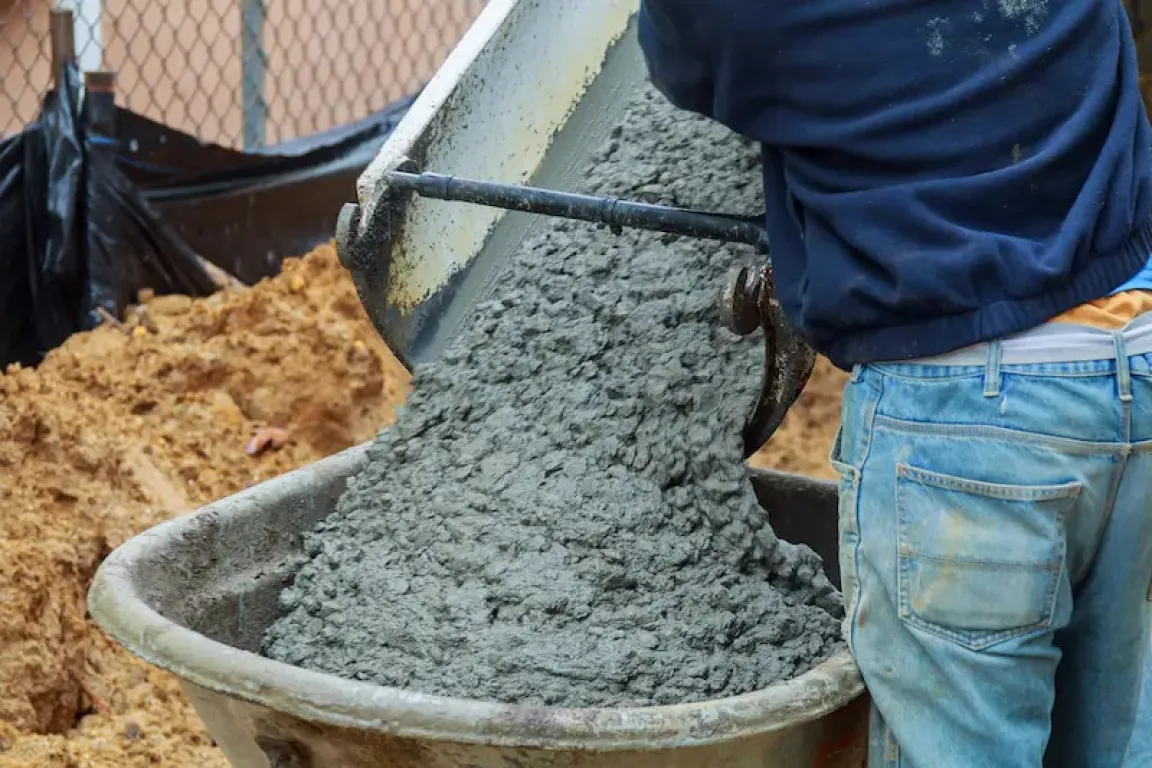Knowing the correct concrete mixing formula is essential knowledge for contractors, especially before starting a foundation construction. A sturdy concrete is made with precise ratios of materials – not too much and not too little.
Mistakes in mixing the materials for concrete composition can be fatal, resulting in a weak structure. Additionally, the foundation must not only be strong but also durable for many years. Therefore, ensure you understand the correct concrete mix ratios.
So, what is the correct concrete mixing formula? This article will discuss it in detail to help you build a durable structure.
Concrete Composition
Concrete is a building element made from a mixture of several materials. This mixture has ratios adjusted to the purpose and function of the concrete. The bonding by cement mixed with water binds coarse and fine aggregates.
Therefore, the concrete mix ratio must be precise to produce high-quality concrete suitable for its purpose. In construction concrete, there are five common components used per cubic meter. Here is the explanation:
Water
Water is a key component in the concrete mix. It can hydrate the cement, leading to the hardening process. Clean water free from harmful chemicals is best for making concrete.
Contractors can still use non-potable water as long as it has a compressive strength of 90% of good water at 7 days (according to SNI 7974-2013). The water content in the concrete mix is 9% per cubic meter.
The water ratio must be precise because too much will affect the quality of the concrete poorly. Conversely, too little water in the concrete mix will impact the workability of the concrete, making it hard to shape and resulting in a more porous outcome.
Cement
Cement acts as a binder in the concrete mix. When mixed with water, cement forms a paste that binds the fine and coarse aggregates together. The most commonly used type of cement is Portland cement.
The cement composition is recommended to be 15%, no more and no less. Excessive use will indeed increase the concrete's strength, but as the cement ratio increases, so does the hydration heat in the concrete, which can lead to cracks (thermal cracks).
A lack of cement ratio also negatively impacts the concrete as it reduces quality and weakens its strength.
Read also: Fix Hairline Cracks in Walls with Cement Mixture
Fine Aggregates
Fine aggregates consist of natural or manufactured sand that passes through a 4.75 mm sieve. They fill the gaps between coarse aggregates, resulting in denser and more homogeneous concrete.
In a concrete mix, fine aggregates are a substantial volume of material, around 35%. However, too much fine aggregate requires more water, which can lead to a decrease in concrete quality.
Conversely, too little fine aggregate makes the concrete mix coarser and more prone to porosity when used.
Coarse Aggregates
Coarse aggregates are gravel or crushed stones larger than 4.75 mm. The volume of coarse aggregates is the highest, about 40%. Coarse aggregates provide strength and structure to the concrete.
The size and quality of coarse aggregates greatly affect the final strength of the concrete. Too much coarse aggregate makes the concrete very stiff and coarse, leading to a more porous structure. Insufficient coarse aggregate makes the concrete smoother (sandy), lowering its quality.
Air
Air is a concrete component that can be present intentionally or unintentionally. The normal air percentage in the concrete mix ranges from 0.7% to 1%. Too much air indicates too many voids and low density in the concrete.
Each 1% increase in air in the concrete mix leads to a 5% decrease in compressive strength. Additionally, air content affects the strength and setting speed of the concrete.
Read also: 5 Ways to Store Cement to Ensure Longevity and Prevent Damage
Concrete Mix Ratios
There are several common concrete mix ratios used for construction or other infrastructure processes. Here are some mixing ratios that determine the strength and characteristics of concrete:
Concrete Mix Ratio 1:2:3
The 1:2:3 concrete mix ratio is one basic method for remembering the composition using material volumes. This ratio is common for small projects or when technical specifications are not very strict.
The ratio of 1:2:3 mix is 1 part cement, 2 parts fine aggregate (sand), and 3 parts coarse aggregate (gravel). For mixing these three components, 0.5 parts water is needed, making a total of 6.5 to produce 1 cubic meter of concrete.
It works by measuring the volume of each material according to the required amount. For example, if using a bucket as a measuring tool, you would use one bucket of cement, two buckets of sand, and three buckets of gravel. Here’s the calculation implementation:
Someone needs concrete with a density of 2,000 kg/m³, so the materials for a strong concrete mix are as follows:
- Cement (1/6.5 x 2,000 kg = 307.7 kg).
- Sand (2/6.5 x 2,000 kg = 615.4 kg).
- Gravel (3/6.5 x 2,000 kg = 923.1 kg).
- Water (0.5/6.5 x 2,000 kg = 153.8 kg).
Concrete Mix Ratio K-225
K-225 concrete is concrete with a characteristic compressive strength of 225 kg/m² after 28 days. This ratio is somehow more popular for better durability, especially for multi-story building construction.
The material composition ratio is similar to the 1:2:3 concrete mix. The density of K-255 concrete is 2,325 kg per cubic meter. Referring to SNI Standard Number 7394 of 2258, here is the manual or site mix for K-255 concrete:
- Cement 371 kg.
- Concrete Sand 698 kg.
- Gravel 1047 kg.
- Water 215 liters.
Read also: Understanding the Importance of Concrete Construction Maintenance
Concrete Mix Ratio K-300
K-300 concrete has a characteristic compressive strength of 300 kg/m² at 28 days. This makes the K-300 concrete mix more complex as it requires high precision. However, SNI has issued guidelines for its material composition, where quality K-300 concrete is made with the following ratio:
- Cement 413 kg.
- Concrete Sand 681 kg.
- Gravel 1021 kg.
- Water 215 liters.
To convert the mix composition into bucket units, you need to know the density of each material to calculate the required amount. Here are the density references for each concrete component:
- Cement = 1,250 kg/m³.
- Sand = 1,400 kg/m³.
- Gravel = 1,350 kg/m³.
Next, divide the concrete mix composition by their respective densities to obtain the bucket ratio. Here’s the complete calculation:
- Cement = 413/1250 = 0.3304.
- Sand = 681/1400 = 0.4864.
- Gravel = 1021/1350 = 0.7563.
Thus,
- Cement : Sand : Gravel = 0.3304 : 0.4864 : 0.7563
- Cement : Sand : Gravel = 1 : 1.47 : 2.29
From this calculation, you can mix 1 bucket of cement, 1.47 (rounded to 1.5) buckets of sand, 2.29 (rounded to 2.3) buckets of gravel, and 215 liters of water.
This concludes the discussion on the concrete mixing formula according to SNI standards. By understanding these formulas, contractors can more accurately estimate the required materials.
In addition to knowing how to mix concrete with the correct ratios, choosing quality building materials is also an important thing to consider when starting a construction project, especially ensuring the quality of cement. In this regard, you can use Semen Merah Putih Watershield.
With premium quality, Semen Merah Putih Watershield provides optimal protection and better durability for buildings. The watershield technology in this cement protects structures from water seepage, inhibits mold growth, and prevents corrosion.
Don't hesitate to use Semen Merah Putih products. If you have further questions about Semen Merah Putih products, please fill out this contact form.
Read also: Advantages and Functions of Reinforced Concrete in Construction



